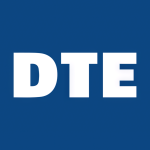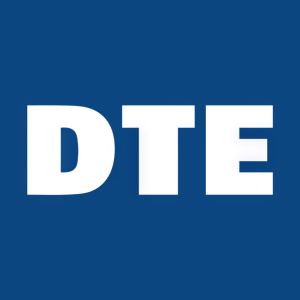Welcome to our dedicated page for Dte Energy Co SEC filings (Ticker: DTE), a comprehensive resource for investors and traders seeking official regulatory documents including 10-K annual reports, 10-Q quarterly earnings, 8-K material events, and insider trading forms.
Trying to locate outage statistics, rate-case impacts, or renewable gas margins inside DTE Energy’s 300-page disclosures? Utility filings are dense, packed with regulatory language and environmental footnotes that make quick analysis difficult.
Stock Titan solves this problem by pairing real-time EDGAR feeds with AI-powered summaries. The platform flags every DTE Energy insider trading Form 4 transactions the moment they post, decodes each DTE Energy quarterly earnings report 10-Q filing into plain English, and delivers a line-by-line view of capital-spending updates. Whether you are tracking grid-modernization budgets in the DTE Energy annual report 10-K simplified, monitoring DTE Energy 8-K material events explained, or comparing executive pay in the latest DTE Energy proxy statement executive compensation, our AI highlights what moves the model so you don’t spend hours hunting through exhibits.
Use cases are practical: receive push alerts for DTE Energy Form 4 insider transactions real-time, benchmark quarter-over-quarter distribution reliability from the 10-Q, or run an instant DTE Energy earnings report filing analysis before earnings calls. Designed for professionals who need facts fast, Stock Titan provides complete coverage—10-K, 10-Q, 8-K, Form 4, S-3, and more—while understanding DTE Energy SEC documents with AI so you can focus on decisions, not decoding.
DTE Energy Company reported two corporate governance developments. Mark W. Stiers, President and Chief Operating Officer of DTE Vantage and Energy Trading, has notified the company that he will retire from his position effective January 12, 2026, and will continue in an advisory role until no later than March 31, 2026. The Board of Directors also approved amendments to the company’s Bylaws, effective December 3, 2025, setting out requirements for shareholders who wish to bring business before the annual meeting, including nominating directors. The amendments further clarify the Board’s authority to hold the annual shareholder meeting by remote communication and include other minor corrections and edits.
DTE Energy Company and its subsidiary DTE Electric Company filed a current report to share information about upcoming investor meetings and related guidance. DTE Energy plans to meet with investors on December 8-9, 2025, using a slide presentation that is furnished as Exhibit 99.1 and made available on its website on December 5, 2025.
In this presentation, DTE Energy discusses 2025 and 2026 operating earnings guidance and notes that certain items affecting reported results, such as non-recurring items, some mark-to-market adjustments, and discontinued operations, will likely be excluded from operating results. The company explains that reconciliations to reported earnings guidance are not provided because it cannot reliably forecast those specific items, which may change significantly over time.
DTE Energy reported an insider transaction by its VP, Corporate Secretary & Chief of Staff. On 11/03/2025, the officer acquired 1,868 shares of common stock at a reported price of $0, recorded under the company’s Savings and Stock Ownership Plan. Following the transaction, beneficial ownership stands at 6,021 shares held directly and 237.45 shares held indirectly through a 401(k).
The footnote states these shares are included per a Plan statement dated November 3, 2025.
DTE Energy Company furnished an 8-K under Regulation FD to announce upcoming investor meetings on November 9–11, 2025 and to provide access to its investor slide presentation.
The company states that its presentation discusses operating earnings guidance for 2025 and 2026. It notes that reconciliations to reported earnings guidance are not provided because specific items such as non‑recurring charges, certain mark‑to‑market adjustments, and discontinued operations cannot be reliably forecast and may vary significantly.
The slide deck is furnished as Exhibit 99.1 and will be available on the company’s website on November 7, 2025. The information in this report, including Exhibit 99.1, is expressly identified as furnished, not filed, meaning it is not subject to Section 18 liability and is not incorporated by reference unless expressly stated elsewhere.
DTE Energy Company filed an 8‑K furnishing the quarterly financial statements of its indirect wholly‑owned subsidiary, DTE Gas Company, for the quarter ended September 30, 2025. The statements were posted to the company’s website on October 31, 2025 and are included as Exhibit 99.1.
As stated under Item 2.02 and General Instruction B.2, this information is furnished, not filed, and is not subject to Section 18 liabilities or incorporated by reference unless expressly stated.
DTE Energy Company, through subsidiary DTE Electric, entered into a Primary Supply Agreement and an Energy Storage Agreement with Green Chile Ventures LLC, a wholly owned subsidiary of Oracle Corporation. DTE Electric will provide approximately 1.4 gigawatts of electric service to a future southeast Michigan data center, with service ramping to full delivery by December 2027. The PSA runs through February 2045 and includes minimum monthly charges and potential termination fees.
Under the ESA, DTE Electric will build and operate approximately 1.4 gigawatts of energy storage at the Customer’s cost, operating each facility for 15 years with options to extend. Oracle, as parent, is providing credit support for both agreements. The full agreements will be filed with DTE Energy’s 2025 Form 10‑K.
DTE Energy Company$3,527 million for Q3 2025, up from $2,906 million a year ago, as utility operations contributed $2,223 million and non‑utility operations $1,304 million.
Operating income rose to $619 million from $517 million, while net income attributable to DTE Energy was $419 million, down from $477 million. Diluted EPS was $2.01 versus $2.30 last year. Drivers included higher fuel and purchased power costs and increased interest expense of $271 million versus $252 million, partially offset by stronger revenues. The quarter also included $50 million of asset losses and impairments, net.
For the nine months, total operating revenues were $11,386 million versus $9,021 million, with net income of $1,093 million versus $1,112 million, and diluted EPS of $5.26 versus $5.36. Shares outstanding were 207,683,012 as of September 30, 2025.
DTE Energy Company furnished an earnings release and slide presentation announcing financial results for the quarter ended September 30, 2025. The materials were provided under Items 2.02 and 7.01 and are included as Exhibits 99.1 and 99.2.
The company discusses 2025 and 2026 operating earnings guidance. Reconciliations to reported earnings guidance are not provided because specific items like non-recurring impacts and certain mark-to-market adjustments can vary significantly. The furnished information is not deemed “filed” under Section 18 of the Exchange Act.
DTE Energy, DTE Electric, and DTE Gas entered into sixth amended and restated five‑year unsecured revolving credit agreements with a lender syndicate and Citibank as Administrative Agent. Commitments are $1,500,000,000 for DTE Energy, $1,000,000,000 for DTE Electric, and $300,000,000 for DTE Gas. Each Facility expires on October 22, 2030 and includes two options to request a one‑year extension.
Borrowings will accrue interest at the borrower’s option of the Base Rate plus the Applicable Margin or Adjusted Term SOFR plus the Applicable Margin. Covenants include a maximum debt‑to‑capitalization ratio of 0.70 to 1 for DTE Energy and 0.65 to 1 for DTE Electric and DTE Gas, along with customary covenants and events of default. Proceeds may be used for general corporate purposes.
Harris Joi M., President & CEO of DTE Energy Co. (DTE), reported purchases of the issuer's common stock on 09/08/2025. The filing shows an acquisition of 7,422 shares under the company's Savings and Stock Ownership Plan, reflected at $0 per share in the table and noted as Plan shares in the explanation. After the reported transaction, the reporting person beneficially owned 32,991 shares directly and held an additional 5,023.64 shares indirectly through a 401(k) plan statement dated September 8, 2025. The Form 4 was signed by an attorney-in-fact on 09/09/2025.


